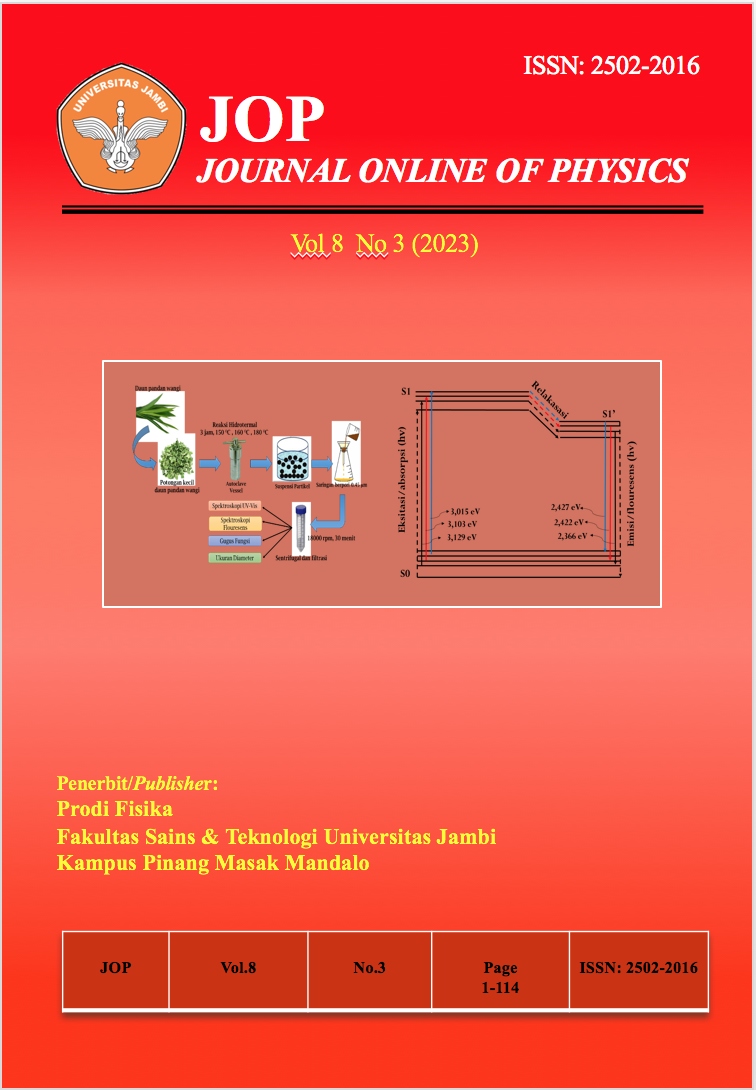RADIOAKTIVITAS ALAM PADA SAMPEL AIR SUNGAI, AIR SUMUR DAN AIR MINUM DI SEPANJANG SUNGAI BATANG HARI, JAMBI
DOI:
https://doi.org/10.22437/jop.v8i3.22213Keywords:
air, radioaktivitas, spektrometer gamma, sungai batang hariAbstract
Sungai Batang Hari merupakan sungai terpanjang di pulau Sumatera yang mengalir melewati Provinsi Sumatera Barat dan Provinsi Jambi. Sepanjang Daerah Aliran Sungai (DAS) Batang Hari masih ditemukan lokasi aktivitas Penambangan Emas Tanpa Izin (PETI) yang beroperasi. Sumber air yang berasal dari sungai maupun bawah tanah di daerah penambangan emas dapat terkontaminasi radionuklida alam seperti Uranium-238 (238U), Torium-232 (232Th), Radium-226 (226Ra), Polonium-210 (210Po), Kalium (40K), dan Timbel-210 (210Pb). Pentingnya untuk menilai kualitas air yang dikonsumsi dari aspek radioaktif, maka perlu dilakukan penelitian pengukuran radionuklida 238U, 232Th, dan 40K pada air sungai, air sumur (bawah tanah), dan air minum dari daerah sampel yang dialiri oleh sungai Batang Hari yaitu Kota Jambi, Kab. Muaro Jambi, Kab. Tebo, Kab. Batanghar, dan Kab. Bungo. Sampel diukur menggunakan spektrometer gamma detektor High Purity Germanium (HPGe). Hasil penelitian menunjukkan konsentrasi aktivitas tertinggi 238U, 232Th, dan 40K masing- masing yaitu 0,1916± 0,05 Bq.L-1; 0,04±0,03 Bq.L-1; dan 0,68±0,04 Bq.L-1. Konsentrasi aktivitas pada sampel air berada di bawah batas ambang yang direkomendasikan oleh PERKA BAPETEN No. 9 Tahun 2009, WHO Guidelines for Water Quality 2011, dan UNSCEAR Report 2000 sehingga aman dan memenuhi syarat standar kualitas radioaktif air.
Downloads
References
Akhadi, M. (2000) Dasar - Dasar Proteksi Radiasi. Jakarta: Rineka Cipta.
Alaboodi, A. S. et al. (2020) ‘Radiological hazards due to natural radioactivity and radon concentrations in water samples at Al-Hurrah city, Iraq’, International Journal of Radiation Research, 18(1), pp. 1–11. doi: 10.18869/acadpub.ijrr.18.1.1.
Avwiri, G. O., Ononugbo, C. P. and Nwokeoji, I. E. (2014) ‘Radiation Hazard Indices and Excess Lifetime cancer risk in soil, sediment and water around mini-okoro/oginigba creek, Port Harcourt, Rivers State, Nigeria’, Comprehensive Journal of Environment and Earth Sciences, 3(1), pp. 38–50.
Awudu, A. R. et al. (2010) ‘Determination of activity concentration levels of 238U, 232Th, and 40K in drinking water in a gold mine in Ghana’, Health Physics, 99(SUPPL. 2). doi: 10.1097/HP.0b013e3181d580ae.
BAPETEN (2009) Peraturan Kepala Badan Pengawas Tenaga Nuklir Nomor 9 Tahun 2009 Tentang Intervensi Terhadap Paparan yang Berasal dari Technologically Enhanced Naturally Occurring Radioactive Material. Jakarta.
Desrizal, D., Carlo, N. and Syah, N. (2019) ‘The Impacts of PETI on the Batang Hari River to the Decline of Water Quality, Land Transfer Function, Socio-Cultural Life and the Community Economy’, Sumatra Journal of Disaster, Geography and Geography Education, 3(1), pp. 54–61.
EPA (2012) Radiation : Facts , Risks and Realities, United States Environmental Protection Agency. Washington, DC. Available at: https://www.epa.gov/sites/production/files/2015-05/documents/402-k-10-008.pdf.
Fakeha, A. et al. (2011) ‘Concentrations of natural radioactivity and their contribution to the absorbed dose from water samples from the Western Province, Saudi Arabia’, Journal of King Abdulaziz University-Science, 23(2), pp. 17–30. doi: 10.4197/sci.23-2.2.
IAEA (2003) Extent of Enviromental Contamination by Naturally Occuring Radioactive Material (NORM) and Technological Options for Mitigation. Vienna: IAEA.
Jobbágy, V., Wätjen, U. and Meresova, J. (2010) ‘Current status of gross alpha/beta activity analysis in water samples: A short overview of methods’, Journal of Radioanalytical and Nuclear Chemistry, 286(2), pp. 393–399.
Kamunda, C. (2021) ‘Toxicity of natural radioactivity in water samples from a gold mine in Gauteng Province , South Africa’, 41, pp. 1–8. doi: 10.6092/issn.2281-4485/10995.
Kamunda, C., Mathuthu, M. and Madhuku, M. (2016) ‘An assessment of radiological hazards from gold mine tailings in the province of Gauteng in South Africa’, International Journal of Environmental Research and Public Health, 13(1). doi: 10.3390/ijerph13010138.
Madzunya, D. et al. (2020) ‘Radiological health risk assessment of drinking water and soil dust from Gauteng and North West Provinces, in South Africa’, Heliyon, 6(2), p. e03392. doi: 10.1016/j.heliyon.2020.e03392.
Mathuthu, M., Uushona, V. and Indongo, V. (2021) ‘Radiological safety of groundwater around a uranium mine in Namibia’, Physics and Chemistry of the Earth, 122(June 2020), p. 102915. doi: 10.1016/j.pce.2020.102915.
PTKMR-BATAN (1998) Prosedur Analisis Sampel Radioaktivitas Lingkungan. Jakarta.
Santawamaitre, T. et al. (2010) An evaluation of the level of naturally occurring radioactive material in soil samples along the Chao Phraya river basin, Nuclear Instruments and Methods in Physics Research, Section A: Accelerators, Spectrometers, Detectors and Associated Equipment. doi: 10.1016/j.nima.2009.10.177.
Skwarzec, B., Strumińska, D. I. and Borylo, A. (2001) ‘The Radionuclides 234U, 238U and 210Po in Drinking Water in Gdańsk Agglomeration (Poland)’. Available at: https://akjournals.com/view/journals/10967/250/2/article-p315.xml.
UNSCEAR (2000) Sources and Effects of Ionizing Radiation Volume I: Sources, UNSCEAR 2000 Report.
USEPA (2020) Thorium. Amerika Serikat: USEPA.
WHO (2011) Water quality for drinking: WHO guidelines. Geneva. doi: 10.1007/978-1-4020-4410-6_184.







